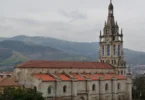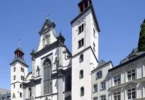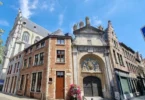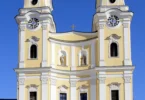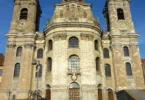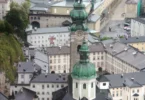
Introduction
The Cathedral of Saint Joseph located in Burlington, Vermont, United States, is the seat of the Catholic Diocese of Burlington. It served at the co-cathedral of the diocese from 1999 to 2018 when it became the cathedral church following the closure of the Cathedral of the Immaculate Conception in Burlington.
- Founded in 1850 (First National French parish in New England.)
- First Church dedicated: August 22, 1850
- Present Church inaugurated on Easter Sunday, April 10,1887.
- Renovated in 1920, 1968 and 2001
- Named a Co-Cathedral in October 1999
Col. Archibald Hyde donated land for the first Catholic Church built in Burlington, which served both Irish and French Canadian immigrants. The French-speaking members felt like second-class citizens in the predominantly Irish congregation. After raising the necessary funds and another donation of land, St. Joseph’s parish was established as the first French Canadian parish in the United States in 1850. A church was constructed to serve the growing French-speaking Canadian population that had immigrated to the North End of Burlington during the mid-19th century.
The present church building was designed in 1883 by Rev. Joseph Michaud who was a self-taught architect hailing from Montreal. He used the Chapel of the Palace of Versailles as his inspiration. The cornerstone was laid on July 4, 1884. It took four years to complete the structure, which relied on the labor and financial sacrifices of its parishioners.
The church was dedicated on St. Jean the Baptist Day (Fête de la Saint-Jean-Baptiste) on June 24, 1887, and blessed by the Archbishop of Montreal, Édouard-Charles Fabre. The church’s seating capacity was designed to accommodate over 1,200 worshipers, and it remains the largest church in Vermont. St. Joseph’s has been renovated in 1920, 1968, and 2000–2001. It was named the co-cathedral for the Burlington diocese in 1999.
Because of low attendance and finances, the process for merging the two Burlington Catholic cathedrals began in 2017. Sunday Masses were celebrated at St. Joseph, while Immaculate Conception had a weekday Mass at Noon and a monthly Mass in Vietnamese. The title to the Immaculate Conception property was transferred to St. Joseph Parish.
In April 2018 Bishop Christopher Coyne decreed that St. Joseph was the sole diocesan cathedral, and later in the year relegated the Immaculate Conception building to secular use. On October 11, 2018, the Diocese of Burlington announced that it would sell the Immaculate Conception property. The last Mass was celebrated in Immaculate Conception Church on December 8, 2018.
History of Cathedral of Saint Joseph, Burlington

The story of St. Joseph’s is, from the beginning, a story of working-class immigrants in a foreign land, isolated from the prevailing and more prosperous Yankee population, especially in the early years, by differences of language, religion and culture as well as by economic status. French-speaking immigrants had been present in the Champlain Valley from the beginning of European settlement, of course.
It was a Frenchman who first explored the Lake, and until the treaty with the English in 1763, the territory on both sides of the lake belonged not to the English colonies, but to New France. Although the earliest settlers had left, a trickle of French-speaking residents of Canada began drifting south early in the Yankee days–a few to fight along with the Americans in the Revolutionary War.
What began as a trickle increased, and was added to by Irish immigrants, so that by 1830 the number of Catholics in the Burlington area had grown to the point that establishing a place of worship was a pressing matter to two bishops–one in Boston to whose jurisdiction Burlington belonged, and one in Montreal concerned about meeting the spiritual needs of his emigrant flock. When the first Catholic church was built in 1832 on land donated by Archibald Hyde and placed in the care of Father Jeremiah O’Callaghan, only part of the need was met.
The trouble was that although the two groups shared a common faith, their language, their culture–even their religious customs–were different. The French often felt like second-class citizens in what was predominantly an Irish congregation. Finally, in 1850, land was donated for a church. Pledges were made, and under the leadership of the bishop of Montreal and a priest recruited from France–and with the help of bazaars, raffles, suppers, picnics, parties and plays, etc., funds were raised to build a church for the French Canadians.
The new church, dedicated to St. Joseph, was roofed and ready for Mass by Christmas 1850–“a bit like the stable at Bethlehem because of its lack of decoration.” It would be 7 years before the plastering was completed and the interior finally finished, but the French Canadians had their parish!
French Canadians continued to migrate to Vermont, and particularly to the Burlington area, throughout the nineteenth century in search of a better life south of the border. (In 1860 the city was the second largest lumber port in the world!) The small brick church on the hill was still too small, and it was no longer central to its parishioners who were concentrated around what is now the Old North End. Before the debt was paid on the first church, lots had been purchased for a new building.
Architecture of Cathedral of Saint Joseph, Burlington
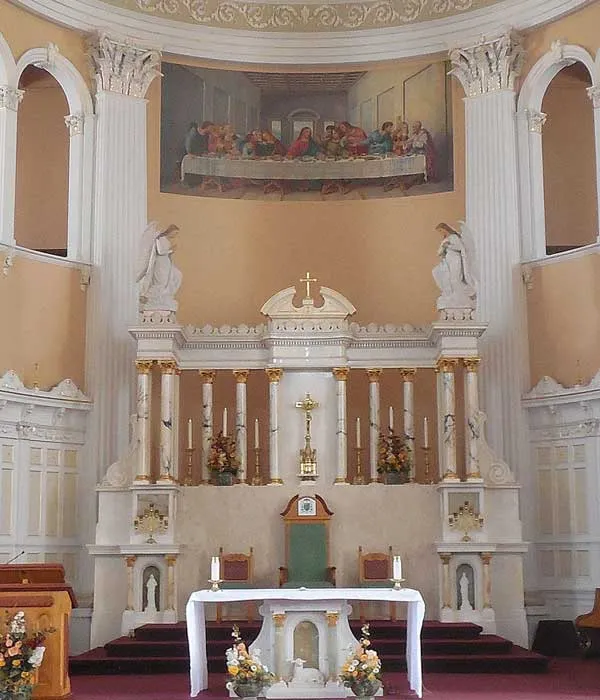
Architectural style: Baroque Revival architecture
Designed by a self-taught architect from Montreal, Rev. Joseph Michaud set forth to construct a magnificent edifice with striking similarity to the Chapel of the Palace of Versailles. St. Joseph’s Church was completed in 1887. Constructed of locally quarried stone, it is a fine interpretation of Baroque Renaissance style architecture. The dimensions alone are impressive: the church itself is 176 feet long and 81 feet wide, with an interior height of 55 feet. St. Joseph’s is the largest church building in the state and lays claim to being the oldest national French Parish in New England.

Steeple
A violent storm in November 2010 damaged St. Joseph’s steeple, and the top portion of it had to be removed in April of the following year. Repair crews had found that the structure had undergone severe deterioration and it was subsequently determined that the 360 kg wrought-iron cross on top was at risk of toppling.
The cross was placed into storage, while the lower sections of the steeple required renovations costing about $200,000. Efforts to restore the steeple to its original height were delayed due to the estimated expense of $1 million, which the church could not afford. Through donations to the repair fund and the sale of the parish’s school building in April 2018 the necessary funds became available. The project was completed in May 2019.
Saint Joseph
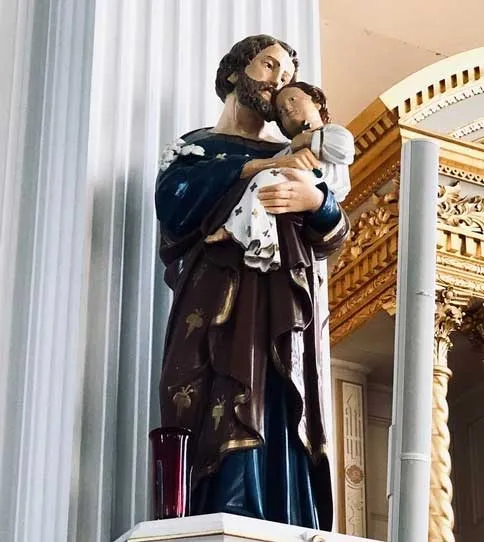
Cathedral of St. Joseph parishioners named their church for the foster father of our Savior Joseph, husband of the Blessed Virgin Mary, appears only a few times in the Bible, where he is described as a just man. We hear accounts of the dreams the Lord sent him to take Mary into his home, and later, to flee to Egypt with Mary and the Baby Jesus to escape King Herod. Joseph also is silent in the Bible: we have no recorded words of the Savior’s earthly carpenter father.
Joseph descended from the line of King David and it was to David’s city Bethlehem that he journeyed to obey the census edict, and where Jesus was born. We celebrate St. Joseph’s solemnity March 19, and on May 1, honor him as patron of workers.
St. Joseph also is patron saint of the Universal Church, and of a happy death. We know him to watch over home buyers and sellers. He also is the patron saint of many Catholic dioceses, and of various cities and countries throughout the world. He now is named in the Eucharistic Prayer at Mass.
A New Church
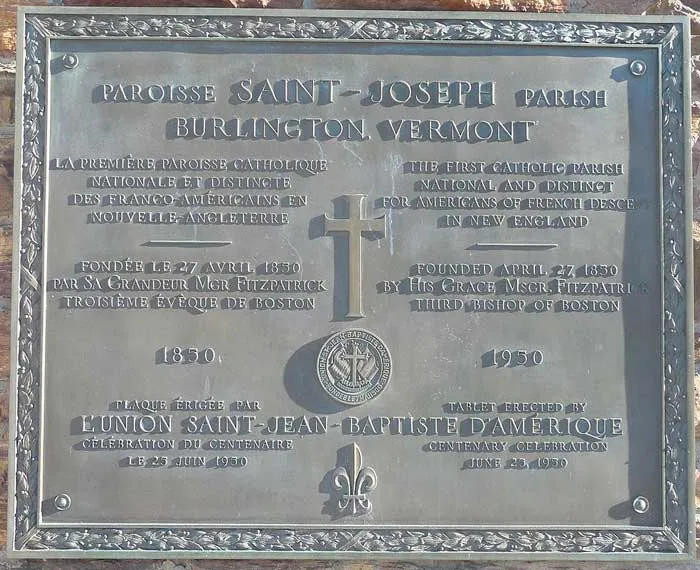
The French Canadian community at its best was a close and family-centered one, and the immigrants’ desire was to re-establish here what they had enjoyed in Canada–a French-speaking community centered around a parish church, a school and a convent. In spite of crowded conditions at the church on the hill, it was 1883 before Bishop DeGoesbriand gave his OK to build a larger church. Although he acknowledged the parish was not rich, he urged that the church be completed within two years!
Over the next four years the building progressed through the faith and sacrifices of the parishioners, along with their determination to succeed and the good wishes of the citizens of Burlington. The red sandstone for the walls (over 5 feet thick at the base) came from a local quarry and was donated to the parish by the Protestant landowners.
Many parishioners with skills as carpenters, stone and brick masons, plasterers and glaziers worked on the project full time or donated one or more days a week of labor to it. Work continued for more than 4 years and was supported by picnics and dances, concerts and card parties, by annual bazaars held at City Hall, which lasted 2 to 3 weeks, and by house-to-house collections in addition to the usual Sunday donations. The new church was finally inaugurated on Easter Sunday 1887, although interior work was still continuing.
The parish is understandably proud of its church, conceived in such a grand classical style symbolic of the universal Church, financed by the sacrifices, large and small, of its parishioners–mostly people of extremely modest means, and built by the actual labor and professional skills of many of these same parishioners. And the result is beautiful.
One architectural historian has praised the church as representing “a stage of artistic refinement and craftsmanship seldom encountered in late nineteenth century architecture”. As the parish history comments, “This magnificent edifice was built by the self-sacrifices of those hardy French Canadian parishioners who placed their faith and their trust in God at the top of their priorities in erecting their own church as a testament to that faith and trust”.
Renovation 2001
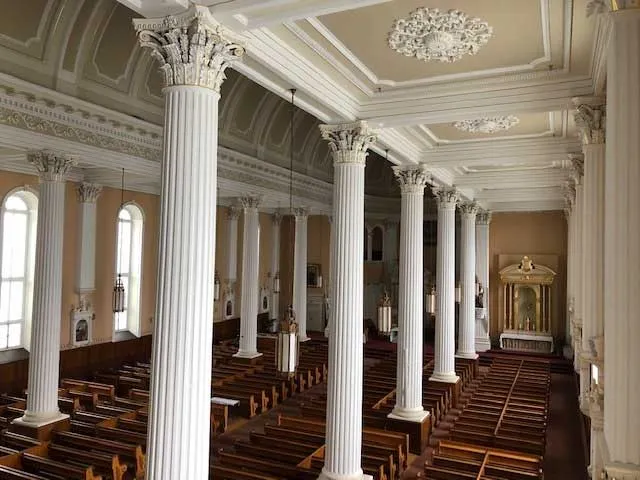
A house built for God should be strikingly beautiful. It should employ the best that we can give. That was the thinking of the French immigrants who built Saint Joseph’s and that was the thinking that guided the present restoration. It is not unreasonable to think of the house of the Lord as the most beautiful house in town. A great church imbues worshippers with a sense of the sacred, and this sense is often achieved through the majesty, of its architectural structure.
Thirty-one years had passed since the last renovation in 1968. Through meetings with the Pastor, Parish Council and parishioners, consensus was achieved to restore the church. Evergreen Studios, a 150 person studio out of New York City was hired to execute the restoration primarily because of their extensive experience in restoration work including: the Vermont State Capitol, the Flynn Theater in Burlington and Saint Patrick’s Cathedral in New York.
Restoration began on November 27, 2000. A unique scaffolding system was designed by Albany Ladder of Williston, Vermont, to support the project. A standard pipe scaffolding supported a wooden platform at the cornice level. Two rolling towers were assembled on the platform that brought workers 51 feet up to the top of the barrel vault ceiling. Two additional rolling towers were assembled in the side aisles enabling painters from Spectrum Finishes Ltd. of Burlington to reach the ceiling emblems in the east and west bays. It took two and a half weeks to erect the scaffolding.
To enhance the beauty of the architectural ornamentation, the cartouche encircling the eight ceiling medallions was glazed. The Baroque scroll, classical cornices and dental work resting on the twelve Roman Corinthian Capitals were adorned with 23-carat gold. In addition to the ornamentation in the ceiling, the Blessed Sacrament Altar, reredos and altar were also gilded.
In the 1920 renovation a stencil was applied above the wainscoting. The stencil was concealed beneath the green paint of the 1968 renovation. Evergreen was able to retrieve the original design and created a new stencil. Much of the original stencil design was kept except for the simple cross that was replaced by an alternating pattern of the Fleurs de les and Bottony Cross.
On April 5th, 1889 the beautiful Stations of the Cross which were purchased in Paris, France, were installed in the church. In the restoration of the stations, Evergreen was responsible for painting, gilding and applying new lettering decals. The original construction of the church enlisted local artisans to help build the church.
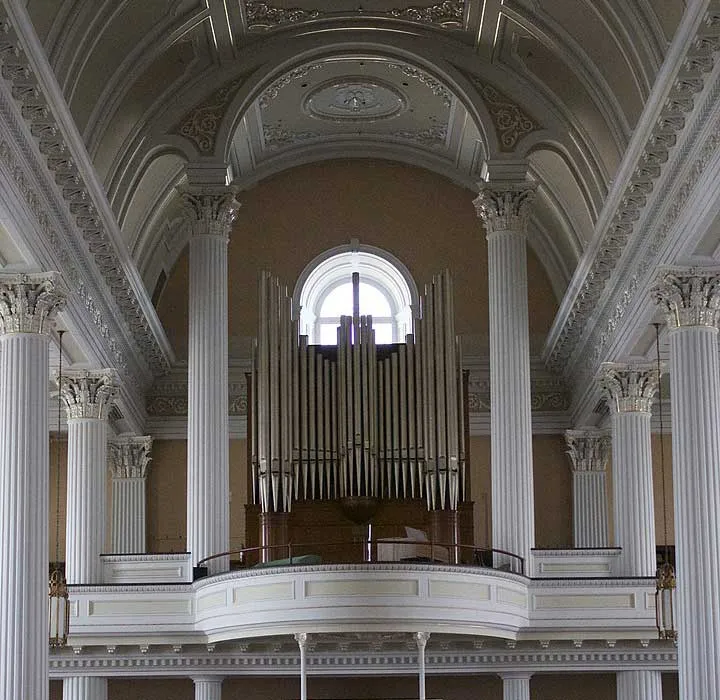
The altar design incorporates several elements from the reredos. Built by A&M Stoneworks of South Burlington, the altar is made of Imperial White Dandy marble from Vermont with four onyx pillars and a central panel from Pakistan. The reredos behind the altar contained three centrally positioned columns of veined marble of Paonazzetto. A&M removed the middle pillar creating a niche for the restored brass crucifix that adorned the main altar prior to the 1968 renovations. Conant Custom Brass of Burlington was responsible for the restoration of the crucifix and the brass chandelier that hangs in the niche over the present Blessed Sacrament Altar, formally St. Anne’s Altar.
The former St. Anne’s Altar was part of the main altar of the 1850 church. It serves as the tabernacle repository. The niche above the altar was completely gilded and provides a striking backdrop for the brass and onyx tabernacle made by Granada Liturgical Arts, Inc. of Madrid Spain. The door of the tabernacle displays a relief of the Coronation of the Virgin painted by the Spanish artist Velazquez in the 1640’s.
Foot traffic that a church building like St. Joseph’s experiences, requires the use of materials that are both durable and beautiful. To handle the heavy traffic and soiling, black walk-off matting was installed by New England Floor covering at the entrance and lobby of the church.
Various lighting effects are now achievable with the installation of dimmer switches controlling the pendant fixtures. Halogen lights were also added to the tabernacle repository. The lighting provides a soft glow on the restored brass chandelier that originally hung in the center of the sanctuary until the renovations in 1968. The end result of four months of design and coordination is a jewel-like interior glowing from the warmth of wood tones and natural light streaming through its frosted windows.
The first Mass in the newly constructed church was celebrated on Easter, April 10, 1887. One hundred and eighteen years later, Bishop Kenneth Angell, Fr. Stephen Hornat, and the parishioners of St. Joseph’s Parish entered a dark church at the Easter Vigil ceremonies on April 14, 2001. As the Gloria was being sung, the lights were gradually turned on revealing the beauty and magnificence of this restored Co-Cathedral.
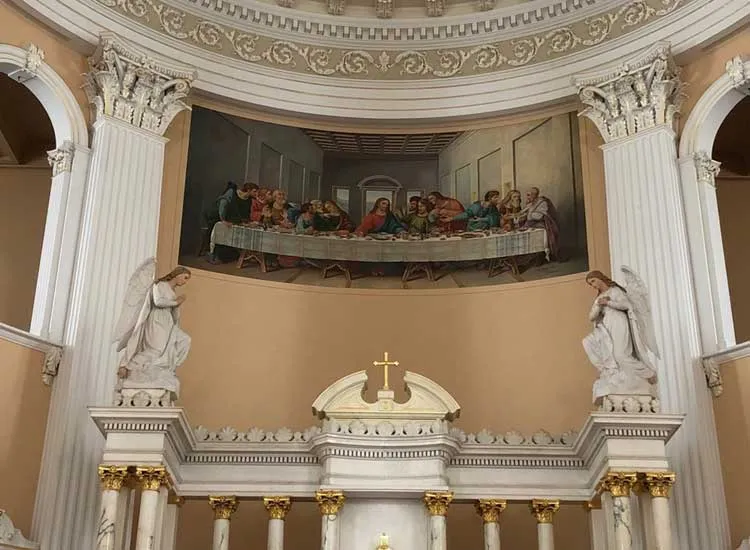
Feast Day – 19th March
Annual Feast Day / Solemnity of St. Joseph held on 19th March.
Mass Time
Weekdays
Saturdays
Sundays
Contact Info
29 Allen Street, Burlington,
Vermont, VT 05401, United States
Phone No.
Tel : +1 802-658-4333
Accommodations
How to reach the Cathedral
Burlington International Airport in Burlington, Vermont, United States is the nearby airport to the Cathedral.
Essex Junction station, also known as Essex Junction–Burlington, is an Amtrak train station in the village of Essex Junction, Vermont, United States is the nearby train station to the Cathedral.


